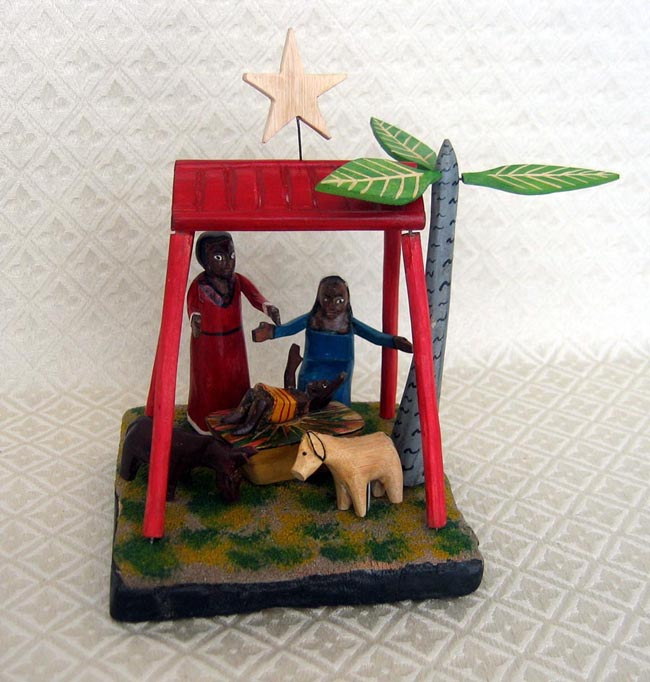OUR COLLECTION — AFRICA — MOZAMBIQUE 152. PAINTED WOOD NATIVITY
This Nativity was hand-carved from mafurreira wood by Samuel Baloi of Mozambique. The style of the carving is called Psikhelekedana, which are miniature models painted in bright colors. The scene measures 6 inches to the top of the tree (not including star).
Psikhelekedana is a traditional art form from the south of Mozambique, initially practiced by people from the Ronga ethnic group. Initially these sculptures reflected the agricultural environment of their makers as they depicted wild animals such as birds, snakes, or crocodiles, or household objects such as spoons, bowls or masks. With urbanization, Psikhelekedana sculptures began to diversify and to depict modern objects like cars, radios or motorcycles or people in the city. Since the 1980s and especially since the end of the Mozambican Civil War in 1992, the dominant trend in this art form is the depiction of events from Mozambican history.
The wood, very pale in color, light and easy to work on comes from the mafurreira, a medium sized tree, which is common in the southern provinces. Roots and branches are used, rather than cutting down the whole tree.
Baloi writes: “I used to live in the Sâo Dâmaso neighbourhood, where I studied up to fifth grade. Because of the war I went with my parents and brothers to Patrice Lumumba. I went back with them to São Dâmaso in 1990. My mother died in 1991, and since my father was ill, I went to work for a consumer cooperative as a shop attendant. In 1992 my father also died, and one of his brothers, who was living in Patrice Lumumba, came to fetch me and my brothers and took us to live with him. In 1995, I went back to my father’s old house, rehabilitated it, and turned it into my house.
“I began to work on my own, making birds, trees, etc. Then Dino contacted me (recognized founder of the new movement), to suggest that we should work together. I worked with him to learn the art and after two months I began to make my own pieces. The first piece I did was of a church, which the client said he was going to offer to the Cardinal of Maputo. I was the first to make pieces of the birth of Rosita and of the Carlos Cardoso murder trial. I sold the former to the representative of the Spanish Red Cross in Mozambique at the time of the floods. I think the best work I have done to date was a piece I carved in 2002 representing community aid to widows and widowers.”
Psikhelekedana is a traditional art form from the south of Mozambique, initially practiced by people from the Ronga ethnic group. Initially these sculptures reflected the agricultural environment of their makers as they depicted wild animals such as birds, snakes, or crocodiles, or household objects such as spoons, bowls or masks. With urbanization, Psikhelekedana sculptures began to diversify and to depict modern objects like cars, radios or motorcycles or people in the city. Since the 1980s and especially since the end of the Mozambican Civil War in 1992, the dominant trend in this art form is the depiction of events from Mozambican history.
The wood, very pale in color, light and easy to work on comes from the mafurreira, a medium sized tree, which is common in the southern provinces. Roots and branches are used, rather than cutting down the whole tree.
Baloi writes: “I used to live in the Sâo Dâmaso neighbourhood, where I studied up to fifth grade. Because of the war I went with my parents and brothers to Patrice Lumumba. I went back with them to São Dâmaso in 1990. My mother died in 1991, and since my father was ill, I went to work for a consumer cooperative as a shop attendant. In 1992 my father also died, and one of his brothers, who was living in Patrice Lumumba, came to fetch me and my brothers and took us to live with him. In 1995, I went back to my father’s old house, rehabilitated it, and turned it into my house.
“I began to work on my own, making birds, trees, etc. Then Dino contacted me (recognized founder of the new movement), to suggest that we should work together. I worked with him to learn the art and after two months I began to make my own pieces. The first piece I did was of a church, which the client said he was going to offer to the Cardinal of Maputo. I was the first to make pieces of the birth of Rosita and of the Carlos Cardoso murder trial. I sold the former to the representative of the Spanish Red Cross in Mozambique at the time of the floods. I think the best work I have done to date was a piece I carved in 2002 representing community aid to widows and widowers.”
